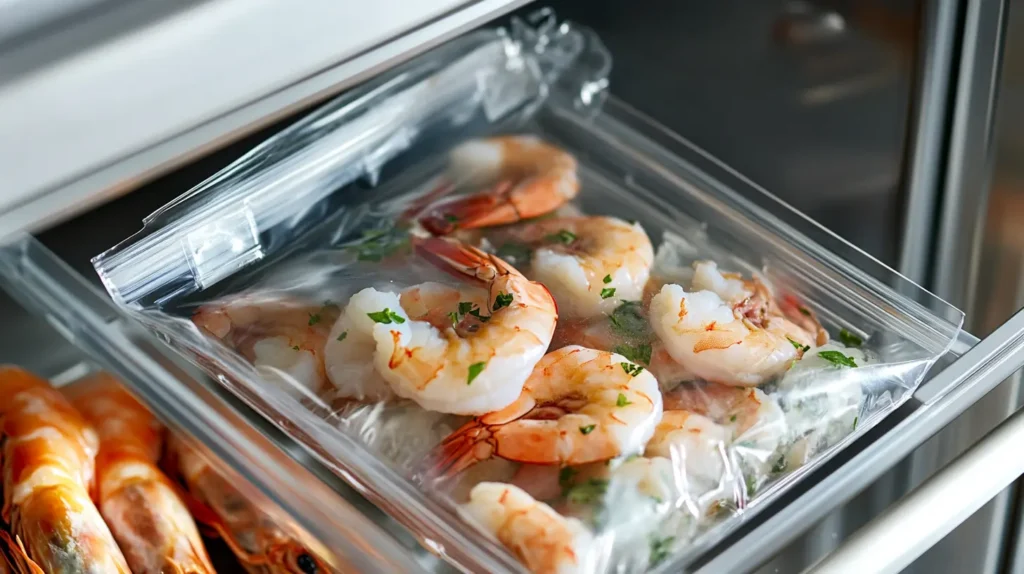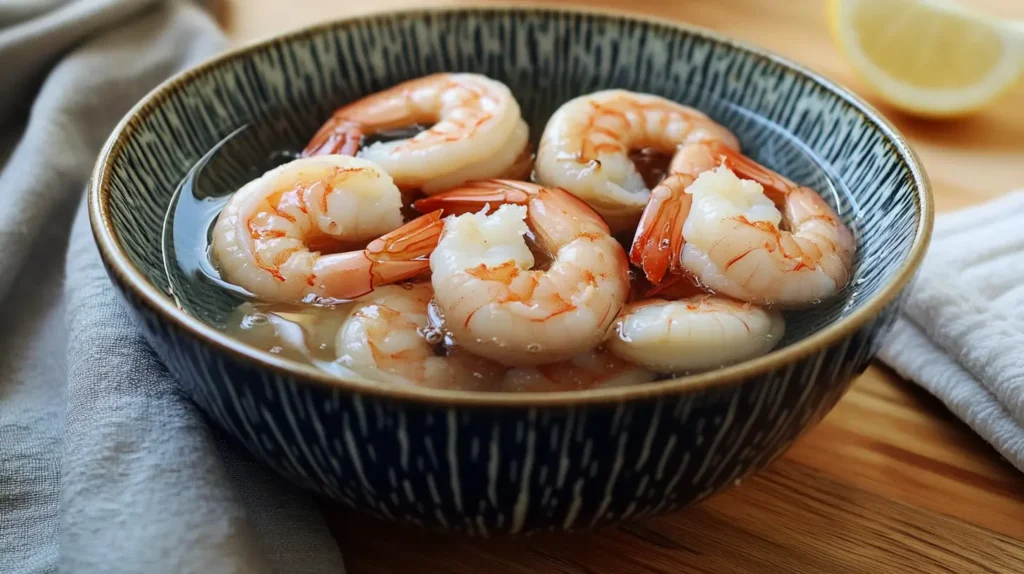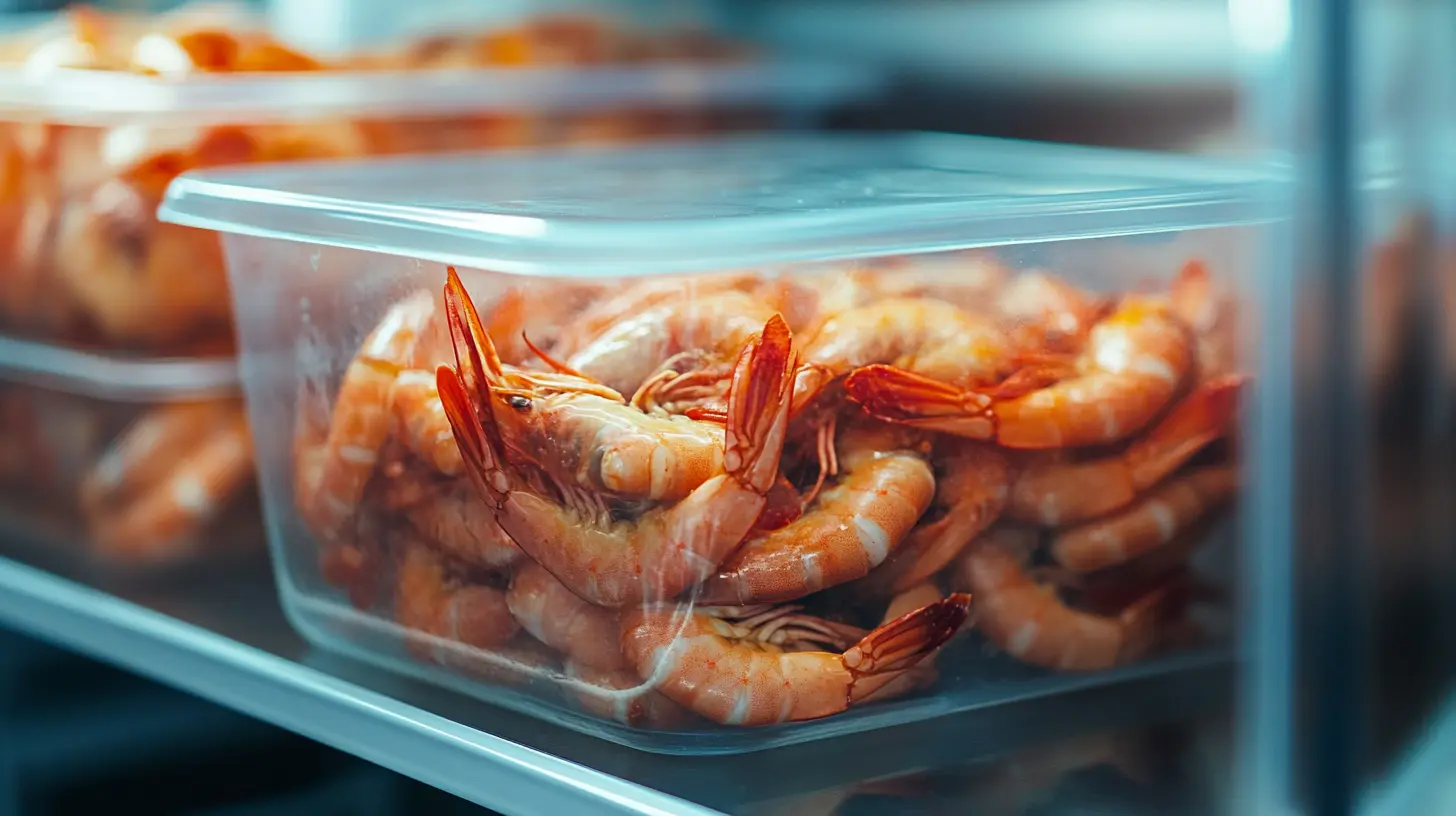Shrimp is a versatile and beloved seafood, perfect for everything from quick snacks to gourmet meals. But once cooked, its shelf life becomes a pressing question for many. Proper storage isn’t just about maximizing freshness—it’s about food safety too. This article dives deep into the details, answering How long can cooked shrimp stay in the fridge? while offering actionable tips on storage, reheating, and spotting signs of spoilage.
Table of Contents
Introduction to Shrimp Storage
What Makes Shrimp a Popular Food Choice?
Shrimp is a global favorite, cherished for its delicate flavor, quick cooking time, and compatibility with countless cuisines. Whether grilled, sautéed, or added to soups, shrimp fits the bill for simple home-cooked meals and extravagant feasts alike.
This seafood is not only tasty but also nutritious, rich in protein, omega-3 fatty acids, and essential vitamins. However, like all seafood, shrimp’s perishable nature means that proper storage is critical to enjoying it safely.
Importance of Proper Storage for Seafood
Seafood, including shrimp, is among the most sensitive food items when it comes to freshness. Improper storage can lead to spoilage, foodborne illnesses, and waste. Storing cooked shrimp correctly helps preserve its texture, taste, and nutritional value. Knowing how to refrigerate or freeze shrimp ensures you can savor your leftovers without risking your health.
By the end of this article, you’ll master the best practices for shrimp storage, from extending its shelf life to identifying signs it’s time to toss it. Ready to dive in? Let’s explore!
Shelf Life of Cooked Shrimp in the Fridge
General Guidelines for Refrigeration
Understanding how long cooked shrimp can stay in the fridge begins with knowing proper refrigeration guidelines. Typically, cooked shrimp can be safely stored in the refrigerator for 3 to 4 days. This timeframe ensures optimal freshness and minimizes the risk of bacterial growth. However, the refrigerator’s temperature must be kept consistently below 40°F (4°C) to slow spoilage.
Cooked shrimp should be stored in airtight containers or tightly wrapped in plastic wrap or aluminum foil. This not only keeps the shrimp fresh but also prevents cross-contamination with other foods.
Factors Affecting Shelf Life: Temperature, Freshness, and Cooking Method
Several factors influence how long your shrimp remains safe to eat:
- Temperature: Fluctuations in fridge temperature can speed up spoilage. Use a thermometer to ensure consistent cooling.
- Freshness at Purchase: Shrimp that was near its expiration date when cooked won’t last as long.
- Cooking Method: Steamed or boiled shrimp typically lasts longer than shrimp coated in rich sauces due to differences in moisture content.
Keeping these variables in check can help extend your shrimp’s refrigerated shelf life.
Signs of Spoilage in Cooked Shrimp
Wondering if your shrimp is still good to eat? Here’s what to watch for:
- Unpleasant Smell: Fresh shrimp has a mild, salty aroma. If it smells sour, ammonia-like, or overly fishy, it’s time to discard it.
- Texture Changes: Spoiled shrimp often feel slimy or sticky, which is a clear indicator of bacterial growth.
- Discoloration: Look for unusual colors like gray or yellowish hues, which may indicate spoilage.
Storing shrimp correctly can prevent unpleasant surprises and protect you from foodborne illnesses.
Safe Storage Practices for Cooked Shrimp
Best Containers for Storing Shrimp
When storing cooked shrimp, using the right containers makes all the difference. Airtight containers made of glass or BPA-free plastic are ideal. These containers seal out moisture and oxygen, keeping your shrimp fresher for longer. Resealable freezer bags can also work well if the air is carefully removed before sealing.
The Role of Proper Wrapping Techniques
If you don’t have an airtight container, wrapping your shrimp tightly in aluminum foil or plastic wrap is a great alternative. Be sure to double-wrap for extra protection. This method minimizes exposure to air and reduces the risk of freezer burn if you decide to freeze your shrimp.
Tips for Maintaining Optimum Refrigerator Temperature
Did you know most refrigerators have warm spots? Store shrimp on the middle shelf where temperatures are more consistent, avoiding the door, where frequent opening and closing cause fluctuations. Regularly check your fridge’s settings to keep the temperature below 40°F (4°C).
Proper storage isn’t just about keeping your shrimp fresh—it’s also about preventing food waste.
Freezing Cooked Shrimp for Extended Shelf Life

When Should You Freeze Cooked Shrimp?
Freezing cooked shrimp is the best way to extend its shelf life when you can’t consume it within the recommended 3 to 4 days in the fridge. Ideally, shrimp should be frozen on the day it’s cooked to lock in freshness. Waiting too long increases the risk of spoilage before freezing.
Shrimp that has been properly frozen can last for up to 6 months without significant loss of texture or flavor. However, always label the container with the freezing date to avoid confusion later.
Steps for Freezing Shrimp Correctly
Follow these steps to freeze cooked shrimp for the best results:
- Cool It Down: Allow shrimp to cool completely before freezing. Placing warm shrimp in the freezer can lead to uneven freezing and frost formation.
- Package Smartly: Use airtight containers, heavy-duty freezer bags, or vacuum-sealed bags to keep out moisture and air. Remove as much air as possible to prevent freezer burn.
- Portion It Out: Divide shrimp into serving-sized portions to make thawing easier and more practical.
If you’re a fan of recipes featuring shrimp, check out this BBQ shrimp recipe for a tasty meal idea.
Thawing Methods for Best Results

When it’s time to use your frozen shrimp, thawing it correctly preserves its taste and texture. Here are three safe methods:
- Refrigerator Thawing: Transfer the shrimp to the fridge and allow it to thaw overnight.
- Cold Water Bath: Submerge the sealed shrimp in a bowl of cold water, changing the water every 30 minutes.
- Direct Cooking: Some recipes allow frozen shrimp to be added directly to the dish, bypassing the need to thaw entirely.
Risks of Consuming Spoiled Shrimp
Common Foodborne Illnesses Linked to Seafood
Seafood is a common culprit of foodborne illnesses when improperly stored. Shrimp, like other seafood, can harbor harmful bacteria like Vibrio or Listeria, especially if left unrefrigerated for too long. Eating spoiled shrimp can result in food poisoning, with symptoms ranging from mild stomach discomfort to severe dehydration or hospitalization.
Knowing how long can cooked shrimp stay in the fridge and following storage guidelines significantly reduces these risks.
Symptoms to Watch Out For
After eating spoiled shrimp, you might experience symptoms such as:
- Nausea and Vomiting: A common early sign of food poisoning.
- Diarrhea: A response to toxins produced by bacteria.
- Fever and Chills: A sign your body is fighting off harmful microorganisms.
If symptoms persist or worsen, consult a healthcare professional promptly.
When to Consult a Healthcare Professional
While mild food poisoning symptoms often resolve within a day or two, severe cases require medical attention. Dehydration, bloody stools, or persistent vomiting should not be ignored.
For more food safety tips and recipe ideas, check out the quick dinner ideas featuring shrimp for inspiration.
Reheating Cooked Shrimp: Dos and Don’ts
Best Practices for Reheating Shrimp
Reheating cooked shrimp properly is essential to retain its taste and texture while ensuring it’s safe to eat. Since shrimp can overcook quickly, low and slow is the way to go.

- Use the Stovetop: Heat shrimp in a skillet over low heat with a small amount of butter or oil. This method preserves moisture and enhances flavor.
- Microwave with Caution: If you’re using a microwave, cover the shrimp with a damp paper towel and heat in short intervals to avoid a rubbery texture.
- Add to Hot Dishes: Shrimp reheats well when added directly to soups, stir-fries, or pasta dishes that are already warm.
Proper reheating ensures that you can enjoy shrimp without compromising its original taste, even after storing it for 3 to 4 days in the fridge.
What to Avoid During Reheating
When reheating shrimp, there are some pitfalls to dodge:
- Avoid High Heat: Cooking over high heat can make shrimp tough and unpleasant.
- Skip Reheating More Than Once: Each round of reheating reduces the quality and increases the risk of spoilage.
- Don’t Leave Out Too Long: Once reheated, consume shrimp immediately to maintain safety.
Understanding how long can cooked shrimp stay in the fridge is just one part of keeping shrimp fresh—knowing how to reheat it properly is equally crucial.
FAQs on Storing Cooked Shrimp
Can You Refreeze Thawed Cooked Shrimp?
Yes, but only if the shrimp was thawed in the refrigerator and hasn’t been left out at room temperature. Refreezing shrimp may affect its texture but is safe when done under proper conditions.
How Does Shrimp Storage Differ from Other Seafood?
Shrimp’s delicate nature makes it more susceptible to spoilage compared to sturdier seafood like salmon. Storing shrimp in airtight containers and consuming it promptly are key to keeping it safe and tasty.
Can Shrimp Be Stored with Other Foods in the Fridge?
Yes, but it’s best to place cooked shrimp in an airtight container to prevent its odor from affecting nearby foods. Shrimp should also be stored away from raw seafood or meats to avoid cross-contamination.
How Long Can Shrimp Stay at Room Temperature?
Cooked shrimp should not be left out for more than 2 hours. If the room temperature exceeds 90°F (32°C), this time reduces to just 1 hour.
Properly handling shrimp ensures you can enjoy it safely. For creative ways to use your leftover shrimp, check out this delicious shrimp dish.
Conclusion: Ensuring Safe and Tasty Shrimp
Key Takeaways on Shrimp Storage
Cooked shrimp is a delicious and versatile ingredient, but its freshness depends on proper storage and handling. Remember, the answer to how long can cooked shrimp stay in the fridge is typically 3 to 4 days when stored at the correct temperature. Use airtight containers and follow food safety tips to keep your shrimp tasting its best.
Whether you’re refrigerating, freezing, or reheating shrimp, these practices not only enhance its flavor but also protect your health. Avoid taking chances with spoiled shrimp by watching for signs of spoilage like bad odors, slimy textures, or discoloration.
Encouragement to Prioritize Food Safety
While shrimp is a crowd-pleaser, its perishable nature means extra care is required. Sticking to these storage guidelines helps you enjoy meals confidently, knowing they are both delicious and safe. Food safety isn’t just a chore—it’s an essential step toward maintaining health and reducing waste.
For more seafood tips or creative recipes featuring shrimp, visit this shrimp preparation guide.
FAQs on Storing Cooked Shrimp
How Long Can Cooked Shrimp Stay in the Fridge?
Cooked shrimp can stay in the fridge for 3 to 4 days when stored properly in an airtight container. Always refrigerate it promptly after cooking to prevent bacteria growth.
What’s the Best Way to Reheat Cooked Shrimp?
The stovetop is the best option, as it retains moisture and flavor. Alternatively, you can microwave shrimp with a damp paper towel to avoid overcooking.
Can You Tell If Shrimp Is Spoiled Just by Smell?
Yes, but it’s not the only indicator. Spoiled shrimp often emits a sour or ammonia-like odor. Check the texture and color as well—sliminess or unusual colors like gray or yellow suggest spoilage.
Should You Freeze Cooked Shrimp If You Can’t Eat It Right Away?
Absolutely! Freezing cooked shrimp is a smart way to extend its shelf life to up to 6 months. Just be sure to store it in a freezer-safe, airtight container.

